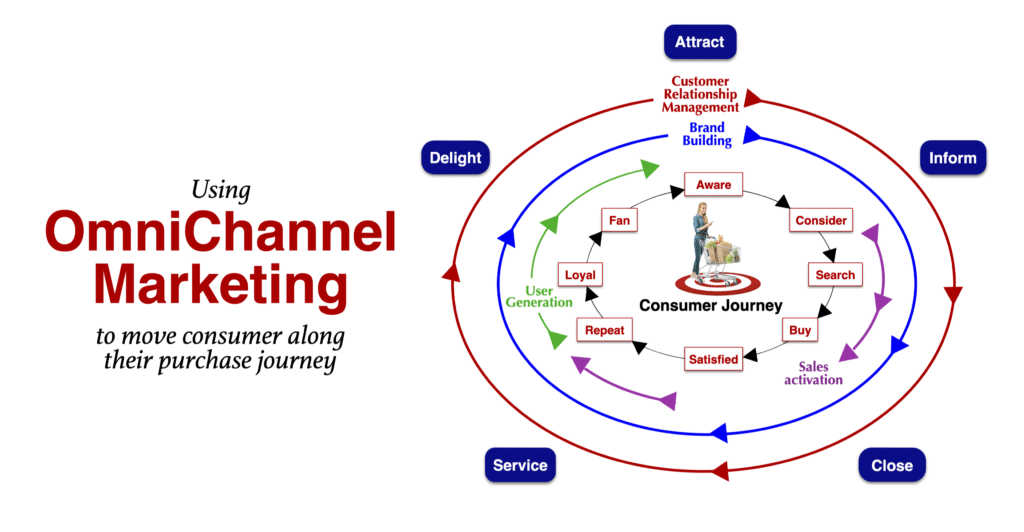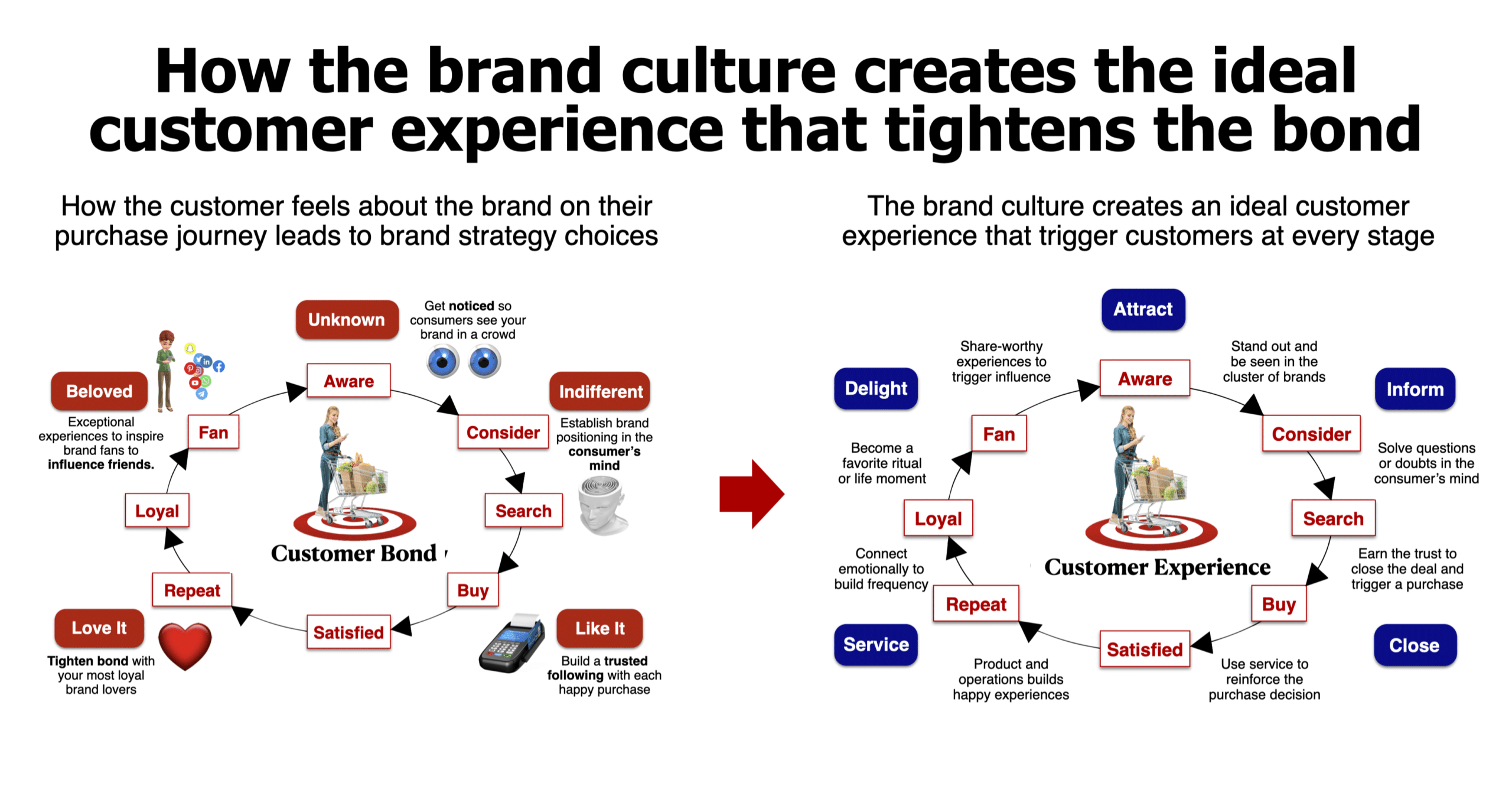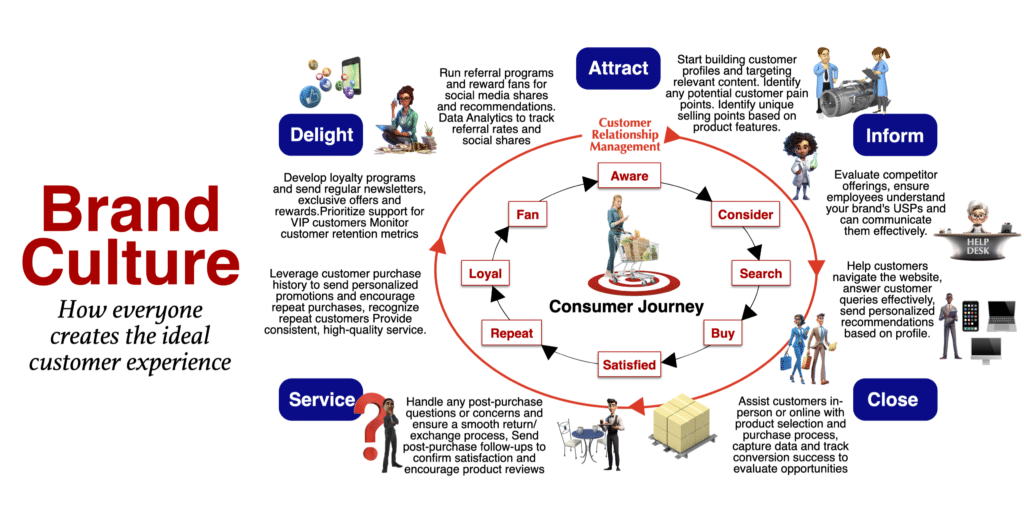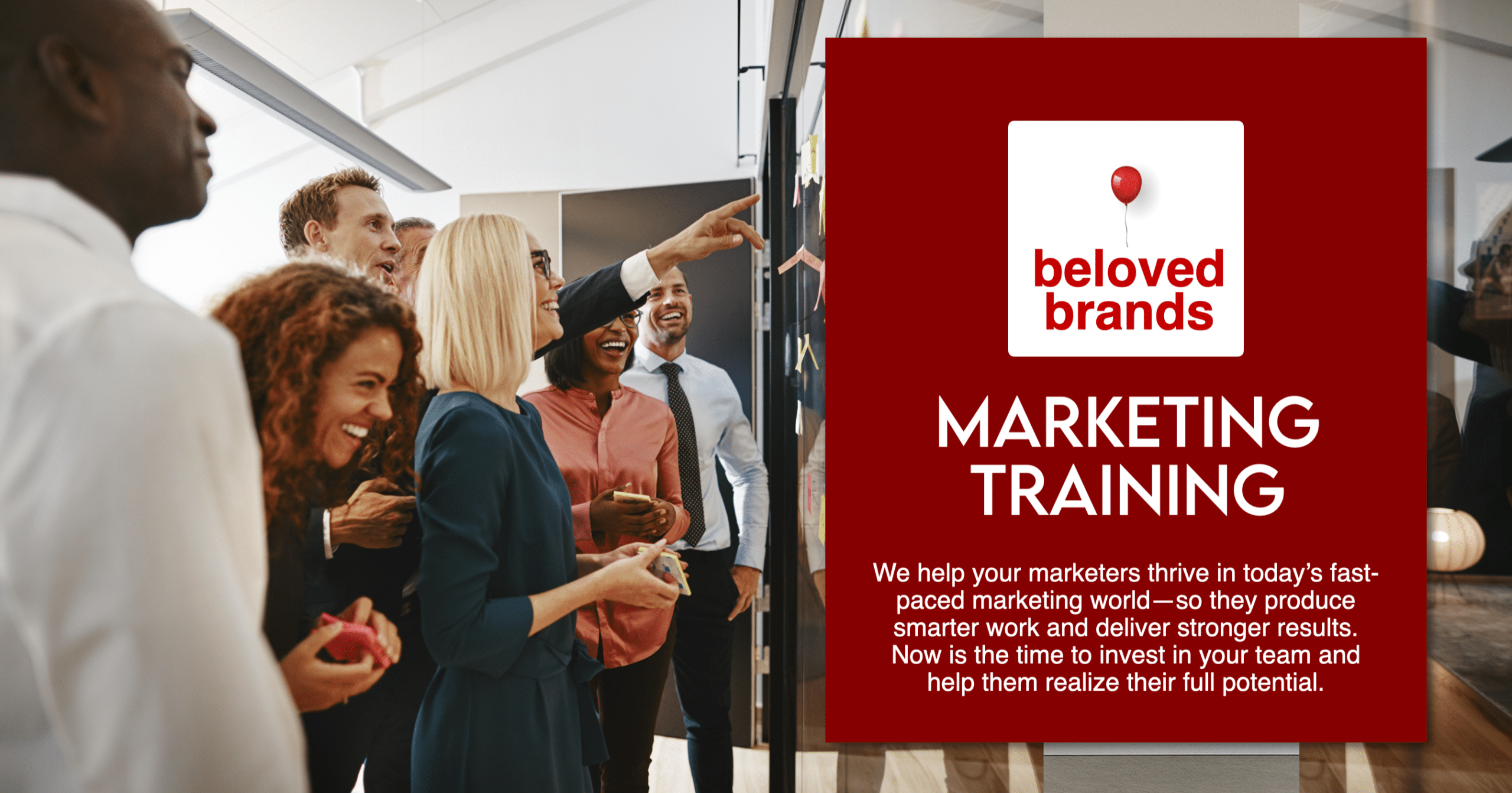In today’s competitive market, the emphasis on “customer experience” and “customer journey” is not merely a trend but an essential business practice. Ensuring an impeccable customer experience is a collective effort, from the top-to-top management down to customer service teams. It’s all about keeping everyone aligned to the brand idea, values, and ideal leader behaviors, ensuring a consistent consumer experience from start to finish.
The Brand Love Curve
The stages include unknown, indifferent, like it, love it, and beloved.
Brands undergo an evolutionary journey similar to personal relationships, progressing through the Five Stages of the Brand Love Curve.
Initially, every brand starts as a complete unknown. Then, with a bit of success, the brand is still a mere commodities at the “Indifferent” stage, fulfilling basic needs without fostering loyalty. Continuing along the curve, the brand advances to the “Like It” phase, gaining more recognition but lacks an emotional bond.
Next, a brand at the “Love It” stage is the starting point to an emotional immersion, as it embeds itself into customer’s daily routines, demanding the brand to nurture this budding connection. An amazing customer experience leads the customers to feel more and think less.
Ultimately, at the “beloved brand” phase, brands elevate from being mere products to iconic symbols, resonating deeply with consumers and inspiring them to advocate for the brand passionately. Creating an amazing customer experience will delight your best brand fans who create awareness among their friends.
To illustrate, click on how the brand love curve steers the strategy of the brand.
Unknown Brand
For emerging brands, they remain an “unknown” entity to consumers. Crafting an exceptional brand culture is vital at this juncture. To stand out amid market noise, these brands must radiate compelling messages that captivate consumer attention, providing an inkling of the unique customer experience they offer.
Indifferent Stage
Within the “indifferent” phase, customers acknowledge the brand but aren’t particularly enthused, treating it like any regular commodity. While these brands cover basic needs, brand culture should drive more than sporadic sales. To get beyond indifferent, brands must use their brand positioning to distinguish the brand. Behind the scenes, a strong brand culture fosters a consistent customer experience, to begin separating the brand from competitors.
Like it Stage
Upon reaching the “like it” level, brands witness preliminary indicators of success. Here, while customer recognize the rationality and functionality of the brand, it’s the absence of a rich brand culture that leads to an unsteady emotional connect. A robust brand culture needs to create a customer experience that evoke feelings, ensuring customers aren’t swayed easily by alternatives.
Love it Stage
At the “love it” stage, the brand begins resonating with its customers on a more profound, emotional level. But a reciprocal emotional bond is crucial: brands should reflect the love they receive from consumers. A strong brand culture helps customers view the brand as part of their daily life, cementing loyalty. Brands should continually nurture this relationship, fortifying the bond with their core supporters.
Beloved Brand
At the “beloved brand” stage, the brand assumes an iconic stature, backed by ardent brand enthusiasts who value and advocate for it. With brand culture at its zenith, consumers not just choose but celebrate the brand. Moreover, it is imperative at this stage to create delightful experiences, powered by their distinctive culture, that will compel your most ardent brand fans to want to tell their friends.
Creating the ideal customer experience
How to engage the brand culture to create the ideal customer experience at every touchpoint.
To illustrate, click on how the brand culture creates the ideal customer experience that tightens the bond
A customer journey consists of numerous touchpoints, each serving as a moment for the brand to emphasize its value, integrate its culture, and heighten loyalty.
Attract:
The initial encounter to kickstart the customer journey. In this phase, marketing and content teams have a pivotal role. Constructing comprehensive customer personas permits precision-targeted and pertinent content. Addressing foreseeable concerns and underlining unique attributes initiates the foundation for more profound engagement. A well-curated brand culture ensures that the customer experience starts on a positive note.
How the brand culture can create the ideal customer experience:
- Build Customer Profiles: By understanding customer demographics, preferences, and behaviors, teams can tailor marketing efforts more effectively.
- Targeted Content Creation: Content teams should collaborate to craft targeted and relevant content that appeals directly to the identified customer profiles.
- Spot Pain Points: Customer service and research teams can help identify pain points in the customer’s initial journey, allowing for better-targeted solutions.
- Highlight Unique Selling Points (USPs): Product teams should clearly communicate product features that stand out, ensuring the marketing teams can spotlight them to potential consumers.
Inform:
Having piqued interest, customers seek deeper insights. This juncture is instrumental in laying down trust and authenticity. Research squads gauge competitors, laying groundwork for distinct product positioning. Continuous training guarantees that all personnel, particularly in customer relations, are acquainted with the brand’s exclusive features. Concurrently, tech teams prioritize crafting an intuitive website journey, making sure the brand culture is consistently communicated.
How the brand culture can create the ideal customer experience:
- Evaluate Competitor Offerings: The research and product teams should keep a tab on competitor products and highlight your brand’s superior points.
- Employee Training on USPs: Regular training sessions ensure that employees, especially sales and customer service teams, understand and can communicate your brand’s USPs.
- Enhanced Website Navigation: The IT and web development teams play a pivotal role in ensuring a user-friendly website experience.
- Effective Query Handling: Customer service should be equipped to answer queries promptly and efficiently.
- Personalized Recommendations: Use CRM and analytics teams to send out personalized content, leveraging data from customer profiles.
Close the Deal:
At the moment of truth of the customer journey, sales representatives become the main players. Their engagements, digital or physical, steer customers towards finalizing a purchase. Behind the scenes, data teams procure insights and discern buying trends to polish approaches, ensuring the brand culture isn’t lost in the transaction but enhances the overall customer experience.
How the brand culture can create the ideal customer experience:
- In-person and Online Assistance: Sales and customer service teams should actively guide customers, providing any necessary assistance.
- Data Capture and Conversion Analysis: The analytics team should consistently monitor conversion rates, providing feedback to marketing and sales teams on where opportunities lie.
Service:
The customer journey doesn’t end after the sale. It’s imperative for the brand to sustain and even elevate the relationship. Customer service manages any post-purchase inquiries or issues, guaranteeing seamless processes. With insights from customer interactions, marketing divisions dispatch bespoke promotions, while customer relationship departments recognize and appreciate returning patrons, embedding loyalty. At this touchpoint, a strong brand culture means offering more than just a product but a continued experience.
How the brand culture can create the ideal customer experience:
- Handle Post-Purchase Concerns: Customer service teams must be proactive in addressing any after-sales concerns.
- Streamlined Return/Exchange Process: Operations and customer service teams need to ensure that return or exchange processes are hassle-free.
- Post-Purchase Follow-ups: Marketing and customer service teams can work together to confirm customer satisfaction and gather reviews.
- Personalized Promotions: The marketing team should collaborate with the analytics team to draft campaigns targeting existing customers, encouraging repeat purchases.
- Recognize Loyalty: Customer service and CRM teams can identify and reward repeat customers to foster loyalty.
Delight:
At this stage of the customer journey, marketing and sales collaboratives launch enticing loyalty initiatives. Regular communiques boasting special deals sustain the brand’s presence in customers’ thoughts. A distinctive customer experience for premium or frequent buyers introduces a bespoke element. Recommendations incentives and active social media interactions not only solidify existing relationships but also extend the brand’s influence, reinforcing the brand culture and its promise to offer unparalleled customer experiences.
How the brand culture can create the ideal customer experience:
- Loyalty Programs: Marketing and sales teams can develop and promote loyalty programs to incentivize repeat purchases.
- Exclusive Offers and Rewards: Ensure regular communication via newsletters, containing exclusive deals for loyal customers.
- VIP Support: Customer service teams should offer prioritized support to high-value or frequent customers.
- Monitor Retention Metrics: Analytics teams should consistently measure customer retention and provide feedback on areas of improvement.
- Referral and Social Media Rewards: Encourage satisfied customers to become brand ambassadors. Marketing and digital teams can track referrals and social shares, rewarding customers accordingly.
Brand Culture
The best brands consistently deliver. When you build your brand idea, I recommend you use a cross-functional team, including salespeople, R&D, human resources, finance, and operations. Their participation is one way to gain their buy-in. But that’s not where it stops.
Use your internal brand communications tools to drive a shared definition of the brand idea. Get everyone to articulate how their role delivers that brand idea. Give the external and internal brand story equal importance to the consumer experience you create for your brand.
Everyone who works on the brand should use the brand idea as inspiration, and to guide decisions and activities across every function of your organization. It is the people within the brand organization who will deliver the brand idea to the consumer. Everyone needs a common understanding of and talking points for the brand.
To illustrate, click on how the brand culture creates the ideal customer experience that tightens the bond
Your brand is more than just a logo or a catchy tagline; it’s a promise to your customers. This promise should resonate consistently across every touchpoint along the customer journey, and this is achieved when everyone involved in your operations, from top management to the shipping team, shares the same vision.
Here’s how to keep all the behind-the-scenes champions aligned for consistent and exceptional customer experiences.
CRM (Customer Relationship Management):
Ensure your CRM system captures the brand promise. Every interaction logged, every piece of communication sent, should echo your brand’s voice and values. Regularly update the CRM team about brand updates or changes to ensure consistent communication at every stage of the customer journey.
Top-to-Top Management:
Management should be the torchbearers of the brand idea. Regular communication sessions ensures everyone understands and buys into the brand idea. You need consistent decision making with every strategic decision should reflect and respect the brand idea.
Sales Team:
Equip the sales team with thorough knowledge about the brand, so they sell not just a product but a story. You need a feedback mechanism to create a two-way feedback mechanism, so the sales team can share on-ground insights, which might influence brand strategies.
Operations:
Brand culture must drive operational consistency. Ensure operations, whether it’s manufacturing or service delivery, are consistent with what the brand promises.Quality Control leads to the ideal customer experience. Regular checks to ensure the quality of the product/service aligns with the brand promise.
Experience Delivery Teams:
Whether it’s in-store staff or service delivery teams, they should understand the brand idea deeply as they often have direct interaction with consumers. Implement systems to gather feedback on the experiences delivered.
Problem Solvers:
Brand-Centric Solutions. While troubleshooting issues, the solutions should be in line with the brand’s identity. For example, a luxury brand’s solution to a problem would differ from a budget brand’s approach.
R&D (Research and Development):
Innovate with the Brand in Mind. Every innovation should resonate with the brand idea. Build customer-centric innovation. R&D should focus on creating products or services that echo the brand idea and drive an ideal customer experience.
Shipping:
Even packaging can reflect the brand promise. Ensure it’s consistent and mirrors the brand’s image. Shipping must be timely and reliable as late deliveries can dent the brand’s customer experience.
Customer Service:
Equip the customer service team to handle queries or concerns in a manner that’s consistent with the brand idea. Regularly analyze customer complaints and feedback at every stage of the customer journey to understand if there’s any inconsistency in building the ideal customer experience
Review and Assess:
Go through each operation aspect periodically. Understand where you’re gaining a competitive edge and where the gaps lie. Use these insights to refine and evolve, ensuring the brand promise remains consistent across the board.
In conclusion, creating a consistent brand experience is like orchestrating a symphony. Every department, every team member is an instrumentalist playing their unique part. When they’re all aligned under the same vision, the result is a harmonious and resonant brand experience that resonates deeply with the consumer.
The leaky bucket
Do you understand why you lose customers at the different stages of the customer journey?
Every marketer should regularly shop their own category. It is shocking when you see such bad service, open inadequate packaging, or meander around a website; you can tell the marketer has never purchased their own brand.
While many think marketing is about putting customers into the funnel, you should also be analyzing why your customers can fall out of the funnel at any moment.
Moreover, our Leaky Bucket tool forces you to look at the various stages a customers goes through as they move along the brand love curve, and then analyze why they reject your brand. Once you understand the problem, you can fix it. Take a look at our leaky bucket tool and assess why your customers are rejecting your brand.
To illustrate, click on how our leaky bucket allows you to figure out why customers are rejecting your brand
Omnichannel Marketing
How to move customers along their journey.
To drive awareness, you need to stand out and be seen in a crowd. Invest in mass media to gain entry into the consumer’s mind using TV, digital, viral video, out of home, or magazine. Where it makes sense, sponsorships, and experiential events can increase the consumer’s familiarity with the brand.
To move consumers to the consideration stage, use influencers to teach those seeking to learn more. Use public relations to make the brand part of the news, whether through traditional, social, or blogger channels. Engage the online user review sites like Yelp, Trip Advisor, or review sites.
Pushing consumers to learn more.
For more complex or higher risk purchase decisions, consumers will rely on search for almost everything, even if to confirm what makes sense. Marketers can use search sites, such as Google, expert review sites, and online content, or long copy print media. The brand website comes into play and should include the right information to close off gaps or doubts, then move consumers towards the purchase decision.
OmniChannel media options to help trigger purchase, include point-of-sale advertising, with in-store signage, displays, and sales materials to prompt consumers at the purchase moment. Remarketing is a great tool to push consumers who might feel stuck at the consideration stage to reconsider and buy.
Building the relationship after the purchase.
After the purchase, turn usage into a ritual among your most loyal users. Cultivate a collection of brand fans, using VIP programs and experiential events with exclusive deals — layer in emotional advertising to tighten the bond. Once you have a strong base, you can mobilize your brand lovers, by intentionally creating shareable experiences, which will trigger brand lovers to share with their network through social media. With the new social media tools, the smartest brands are getting their most engaged consumers to drive awareness.
Marketers need to use the OmniChannel media approach to move consumers at every stage.

Advertising Decisions
The Creative Brief defines the box.
At Beloved Brands, we believe the best creative people are in-the-box problem solvers, not out-of-the box inventors. This builds on our Strategic ThinkBox we used in our planning process. The box below demonstrates how we need creative work that is focused on the target, fits with the brand, delivers the message, and executes the strategy.
As marketers, we kick off the advertising process using a Creative Brief to define the box the creative advertising must play in. The execution align with the brand positioning work and deliver the brand strategy statements you wrote in your marketing plan. Moreover, we show examples of the good and bad of the Creative Brief. And, we introduce our Mini Brief for smaller projects and the Media Brief as part of media decisions. We have a Creative Brief template you can use.
As marketers, we kick off the advertising process using a Creative Brief to define the box the creative advertising must play in. The execution align with the brand positioning work and deliver the brand strategy statements you wrote in your marketing plan. Moreover, we show examples of the good and bad of the Creative Brief. And, we introduce our Mini Brief for smaller projects and the Media Brief as part of media decisions. We have a Creative Brief template you can use.
Use our Creative Checklist to determine if the creative work is in the box.
Then, we introduce a Creative Checklist that is designed to help you make advertising decisions. When you see the creative marketing execution come back from your experts, use our creative checklist to make decisions. Next, use your feedback to your marketing experts to steer the ideas back in-the-box. Importantly, the Creative Checklist highlights the gaps you see. Your role is to provide your problems with the work, while avoiding providing a solution. Let your creative marketing execution experts use their in-the-box creativity to figure out new solutions that will fit the box.
To illustrate, click to review how our Creative Checklist helps decide if the creative advertising fits the box..
Use our ABC's of Advertising: Attention, brand link, communication stickiness
Here are four questions to ask:
- First, is it the creative idea that earns the consumer’s attention for the ad?
- Then, is the creative idea helping to drive maximum brand link?
- Next, is the creative idea setting up the communication of the main consumer benefit?
- And, is the creative idea memorable enough to stick in the consumer’s mind and move them to purchase?
To illustrate, click on the ABC’s of advertising to see details.
Get comfortable with various advertising techniques.
Learn how to be better at advertising. Explore other advertising ideas such as emotional advertising, humorous ads, feel-good ads, and ads that bring consumer insights to life. Moreover, read how to conduct your own marketing research, social media plans, or using influencers.
Video on how to use in-the-box creativity
Have a look at our video on how to use in-the-box creativity to ensure our marketing execution stays on strategy. We introduce how our Creative Brief defines the box the work must play in. And, our Creative Checklist to allow you to decide if the marketing execution delivers. To read more, click on this link: How to use in-the-box creativity.
To view, use the ▶️ controls to play our brand strategy video.






















